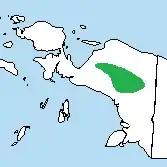| Snow Mountain quail | |
|---|---|
 | |
| Illustration of female and male (in front) | |
| Scientific classification | |
| Domain: | Eukaryota |
| Kingdom: | Animalia |
| Phylum: | Chordata |
| Class: | Aves |
| Order: | Galliformes |
| Family: | Phasianidae |
| Genus: | Synoicus |
| Species: | S. monorthonyx |
| Binomial name | |
| Synoicus monorthonyx (van Oort, 1910) | |
 | |
| Synonyms | |
|
Anurophasis monorthonyx van Oort, 1910 | |
The Snow Mountain quail (Synoicus monorthonyx), is a roughly 28-cm-long (11 in), dark brown quail of alpine grasslands. It was formerly considered the only member of the genus Anurophasis, but phylogenetic analysis places it as the sister species to the brown quail (S. ypsilophorus) in the genus Synoicus.[2] It has heavily marked brown plumage, a pale yellow bill, yellow legs and a brown iris. The underparts of the female are whitish and more distinctly barred black than in the male.


The Snow Mountain quail is confined to Western New Guinea's highest elevations, the Snow and Star Mountains. This little-known bird is protected only by the remoteness of its habitat, a mostly inaccessible area at altitudes of 3,000–4,200 m (9,800–13,800 ft).[1]
The female usually lays up to three, pale brown, dark-spotted eggs in a hollow nest under the edge of a grass tussock. The diet consists mainly of seeds, flowers, leaves, and other vegetable matter.
Due to its limited range, parts of which are getting increasingly accessible, the Snow Mountain quail is evaluated as "near threatened" on the IUCN Red List of Threatened Species.[1]
References
- 1 2 3 BirdLife International (2016). "Anurophasis monorthonyx". IUCN Red List of Threatened Species. 2016: e.T22678993A92797522. Retrieved 13 February 2020.
- ↑ Hosner, Peter A.; Tobias, Joseph A.; Braun, Edward L.; Kimball, Rebecca T. (2017-05-17). "How do seemingly non-vagile clades accomplish trans-marine dispersal? Trait and dispersal evolution in the landfowl (Aves: Galliformes)". Proceedings of the Royal Society B: Biological Sciences. 284 (1854): 20170210. doi:10.1098/rspb.2017.0210. PMC 5443944. PMID 28469029.
